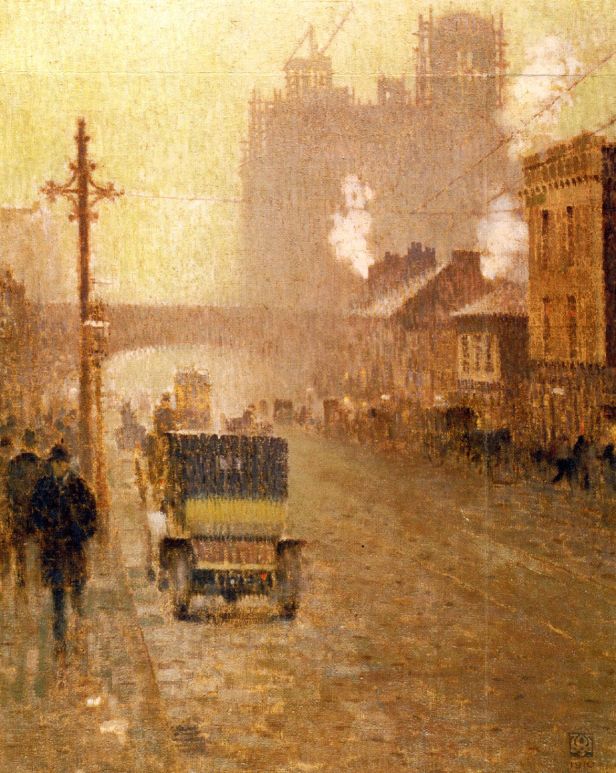
While we were in Manchester yesterday we visited the Manchester Art Gallery which has a room devoted to the French artist, Adolphe Valette, who came from his home in St Etienne, France, to England in 1904 and, from 1906 to 1920, taught at Manchester School of Art where he influenced LS Lowry, his most famous pupil.
The centrepiece of this gallery is a superb group of impressionistic paintings of Edwardian Manchester, painted between 1908 and 1913, which represent Valette’s most significant artistic achievement.
‘These memorable and enduring paintings capture the genesis of a modern metropolis where past and present collide. In them a dense industrial ether of smoke, steam and fog envelops the Edwardian city’s streets and hangs gloomily over its rivers and canals.’
– Adolphe Valette, A French Impressionist in Manchester, Manchester Art Gallery
When Valette returned to France in 1928, nine of his atmospheric paintings of the city were acquired by Manchester Art Gallery which now has by far the largest holding of his work. These included his most ambitious work, Albert Square 1910 (above) which shows the busy city square with its Victorian Town Hall and Albert Memorial bathed in fog. On the far side of the street, is a hansom cab, parked beneath the statue of Gladstone. Behind the statue looms the hazy silhouette of the Town Hall. The softly painted tones reflect his French Impressionist influences.

It’s possible that Valette saw Monet’s Thames paintings, such as ‘Charing Cross Bridge 1902’ (below), when they were exhibited in Paris in 1904. Valette seems to have had a love affair with Manchester’s smog-ridden atmosphere, discovering the same qualities of light that Monet found in the London fogs on the Thames a few years earlier.
.jpg)
Just as in Monet’s painting, in ‘Under Windsor Bridge’ 1912 (below) the forms are dematerialised by the industrial haze. The composition is anchored by a ‘Mersey flat’, the type of barge used to carry grain, cotton and coal along the Ship Canal from Liverpool to Manchester. There’s a lone silhouetted figure taking in the scene that prefigures those in Lowry’s work. This painting was exhibited in Liverpool in 1909 at the Walker Art Gallery’s autumn exhibition.

Valette’s paintings of the mist-shrouded waterways of Manchester can also be compared with Whistler’s ‘nocturnes’, such as ‘Nocturne – Blue and Gold’ (below).

In 1910. Valette again exhibited in Liverpool and reviewers singled out for praise ‘Oxford Road, Manchester’ (below), calling it ‘a fine impression conveying all the greyness and sombre dignity of the city’. The building under construction in the painting is the Refuge Assurance Building, designed by Alfred Waterhouse.

‘Old Cab at All Saints’ (below) shows a smog-filled, autumnal scene of a hansom cab parked at the curb of Grosvenor Square (All Saints) on Oxford Road, Manchester.

‘An Organ Grinder’ by LS Lowry (below) is displayed nearby to illustrate the connection between Valette’s images and the work of his student, inspired to paint the urban landscape as a result Valette’s example.

Lowry said: “I cannot underestimate the effect on me at that time of the coming into this drab city of Adolphe Valette, full of the French Impressionists, aware of everything that was going on in Paris … I owe so much to him”.

This exquisitely-worked pastel by Valette, ‘Rooftops, Manchester’, is truly evocative of a rain-soaked and sooty winter’s afternoon in industrial Manchester, and again displays an approach that was to influence Lowry.
‘York Street Leading to Charles Street’ (below) was painted in 1913 and, in its depiction of townscape with street labourers, connects with the work of the Camden Town Group from the same period. This was to be the last painting Valette made of Manchester.

‘It is not known why Valette chose to live and work in Manchester, or why he ceased to paint the seminal impressionistic views of the city that absorbed him for many years, and for which he is now acclaimed.’
– Adolphe Valette, A French Impressionist in Manchester, Manchester Art Gallery
Wonderful to see this sadly under valued painter celebrated. Thank you for sharing these excellent images.
Sadly, most of the paintings by Valette have been put into storage at Manchester Art Gallery.
Only 4 are now exhibited. Still worth seeing, but what a loss to Manchester.
One year on and there are still only 4 on view, it’s a shame